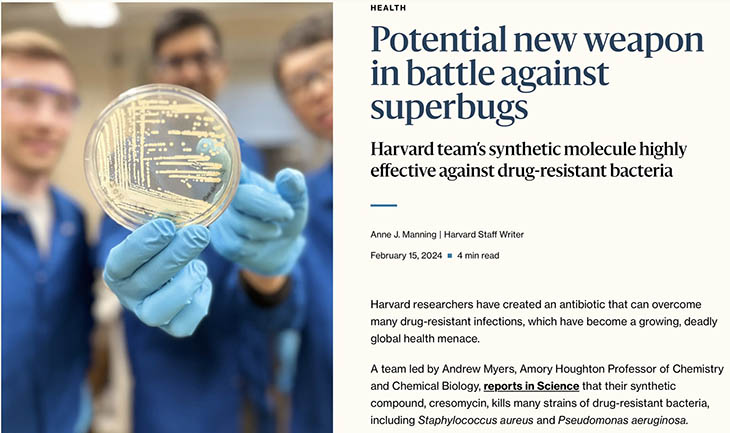
Harvard researchers have developed a groundbreaking antibiotic named cresomycin, designed to combat the increasingly perilous threat posed by drug-resistant infections. These infections, responsible for claiming the lives of approximately a million individuals annually, have emerged as a dire global health crisis.
Cresomycin stands out for its remarkable efficacy in combating deadly superbugs that have evolved resistance to conventional antibiotics, such as Staphylococcus aureus and Pseudomonas aeruginosa. This synthetic compound, crafted by a team of scientists from Harvard University, marks a significant stride forward in the ongoing battle against antibiotic-resistant bacteria.
Led by Professor Andrew Myers, a distinguished figure in the field of Chemistry and Chemical Biology, the research team detailed their findings in the prestigious journal Science. They highlighted how cresomycin boasts an enhanced capacity to bind to bacterial ribosomes, crucial biomolecular machinery governing protein synthesis.
Notably, disrupting ribosomal function serves as a cornerstone in the mechanism of action for many existing antibiotics. However, the emergence of superbug strains equipped with shielding mechanisms has rendered traditional treatments ineffective. Cresomycin’s innovative design draws inspiration from the chemical structures of ‘lincosamides’, a class of antibiotics to which the commonly prescribed clindamycin belongs.
While clindamycin is typically produced through semi-synthesis—where natural compounds are modified for medicinal purposes—the creation of cresomycin represents a paradigm shift. Unlike its predecessors, cresomycin is entirely synthetic, featuring chemical modifications inaccessible through conventional methods. This pioneering approach opens new avenues in the pursuit of novel antibiotics capable of tackling the evolving threat of drug-resistant infections.
“By leveraging the power of organic synthesis, we are limited almost only by our imagination when designing new antibiotics,” said Ben Tresco, the study co-author. “The bacterial ribosome is nature’s preferred target for antibacterial agents, and these agents are the source of inspiration for our program.”
Bacteria can develop resistance to antibiotics through the expression of genes that encode enzymes known as ribosomal RNA methyltransferases. These enzymes essentially create a shield around the ribosome, preventing the antibiotic components from attaching and disrupting its function, thereby rendering the antibiotic ineffective.
To address this challenge, Dr. Myers and his research team devised a novel approach. They engineered a compound with a rigid structure that closely mimics the shape of the target site on the ribosome. This structural similarity enhances the compound’s ability to bind tightly to the ribosome, overcoming the bacterial resistance mechanism.
This new drug, dubbed cresomycin, boasts a unique advantage termed ‘pre-organization’ for ribosomal binding. Unlike conventional drugs, which must expend energy to adjust their shape to fit the target site, cresomycin is already pre-configured to bind efficiently to the ribosome. This characteristic streamlines the drug’s action and potentially enhances its effectiveness against resistant bacteria.
The researchers utilized a cutting-edge method known as component-based synthesis, pioneered by the Myers Research Group. This technique involves constructing individual molecular components of equal complexity and assembling them into the final compound at later stages. This process is likened to assembling sections of a complex LEGO set before joining them together.
The modular and entirely synthetic nature of this approach enables the rapid generation and testing of numerous candidate molecules. By synthesizing and evaluating multiple compounds simultaneously, the drug discovery process is significantly accelerated, offering hope for the development of novel antibiotics to combat resistant bacterial infections.
“While we don’t yet know whether cresomycin and drugs like it are safe and effective in humans, our results show significantly improved inhibitory activity against a long list of pathogenic bacterial strains, compared with clinically approved antibiotics,” Myers shared in a Harvard media release.
“Antibiotics form the foundation on which modern medicine is built,” Kelvin Wu, co-author of the study, had pointed out. “Without antibiotics, many cutting-edge medical procedures like surgeries, cancer treatments, and organ transplants, cannot be done.”
The initial phase of this research gained crucial backing from Harvard’s Blavatnik Biomedical Accelerator in 2013. Their funding empowered the laboratory to commence testing various drug compounds. Additionally, ongoing investigations led by Myers have garnered significant support, with a recent grant of $1.2 million from a nonprofit organization. This substantial funding injection aims to propel the development of oral antibiotics capable of combatting the growing threat of drug-resistant infections, marking a pivotal step towards addressing this global health challenge.



